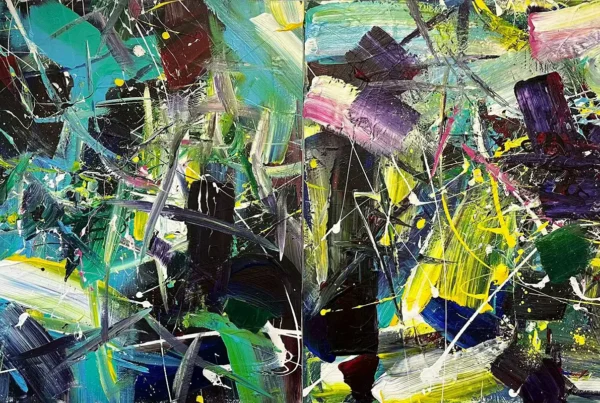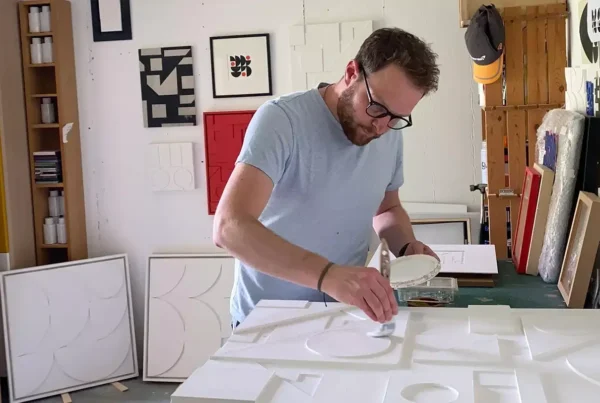Color as Compass: A Journey Through Contrast and Clarity
Emerging from the quiet beauty of the Allgäu and now rooted in Berlin’s electric creative pulse, Peter-Maximilian Ronsdorf has carved out a singular place within contemporary abstraction. Born in Duisburg in 1999 and raised in southern Germany, he began exploring color and form early on, guided by a vivid instinct for expression. This lifelong engagement with visual storytelling led him to pursue a specialized arts diploma, followed by formative years in Nuremberg, where access to a studio gave him the freedom to experiment on a larger scale. It was during this time that his artistic language began to solidify, shaped by foundational influences including Jean-Michel Basquiat’s explosive energy, Gerhard Richter’s nuanced surface manipulations, and the lyrical mark-making of Cy Twombly.
Ronsdorf’s trajectory has been anything but linear. After pausing a vocational training path and searching for a sustainable future, he relocated to Berlin. While immersed in fashion design studies, he refused to set aside painting, instead allowing his art to flourish in tandem. This dual engagement sharpened his sensibilities and deepened his understanding of structure, palette, and conceptual intent. February 2022 marked a pivotal moment when he unveiled his first solo exhibition, stepping fully into the life of a freelance artist. A year later, the emergence of his “Helium” series crystallized his identity as a painter—this body of work revealed not just a consistent visual direction but a foundational thread that continues to shape his evolving practice.
Today, Ronsdorf’s work moves fluidly between calm, tonal gradients and more visceral, expressive canvases. His approach embodies both rigor and spontaneity, echoing the philosophical tensions at the heart of his influences. While deeply personal in genesis, his compositions invite broad interpretation. He doesn’t aim to dictate meaning, but rather to build a space where viewers can encounter themselves through shifts in light, motion, and feeling. His art is less about telling a story than about offering a visual atmosphere in which many stories can unfold simultaneously.
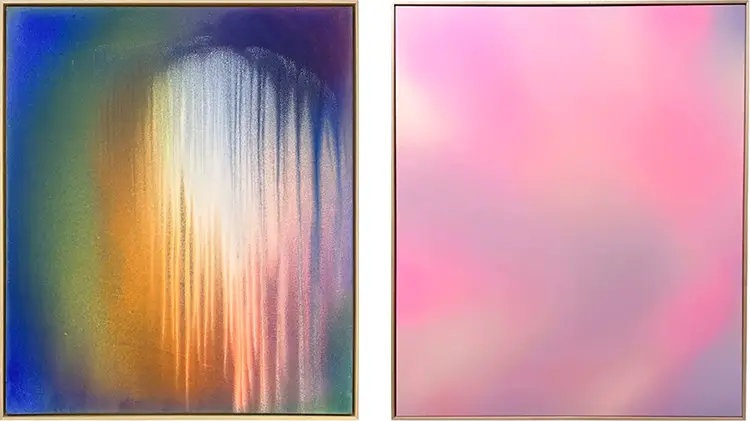
Peter-Maximilian Ronsdorf: A Duality of Series, A Dialogue of Forces
The “Helium” and “Counterpoint” series stand as two anchor points in Ronsdorf’s current oeuvre, contrasting approaches that reflect divergent emotional landscapes yet share a subtle interdependence. “Helium” is characterized by its fluid transitions and gentle luminosity, composed from pastel hues and soft tones that glide seamlessly into one another. These paintings offer a sense of visual exhalation—peaceful, expansive, and nearly weightless. They are meditative without being passive, delivering a kind of silent intensity through layered transparency and muted glow. The visual language here prioritizes subtle modulation, guiding the viewer toward moments of quiet revelation.
In stark contrast, “Counterpoint” (and its offshoot, “Falling Flowers”) presents a raw, impulsive counterweight. Created with oil paints and often layered over previous imagery, these works push toward chaos. Decaying floral motifs reappear, not as delicate symbols but as energetic fragments within thick, gestural compositions. The process becomes one of excavation as much as creation: surfaces are scraped, reworked, and intuitively reimagined. This series resists neatness and embraces unpredictability, channeling an emotional immediacy that verges on the anarchic. Whereas “Helium” leans into restraint, “Counterpoint” revels in rupture.
Yet Ronsdorf sees these series not as opposites, but as companions within his creative life. They engage in a dialogue of motion and stillness, order and accident. Each speaks to a different aspect of his character and to the fluctuating demands of artistic expression. “Helium” offers pause; “Counterpoint” insists on action. One is an inward breath, the other an exhalation. Together, they reflect the complexity of a practice that resists simplification and instead embraces contradiction as a generative force.
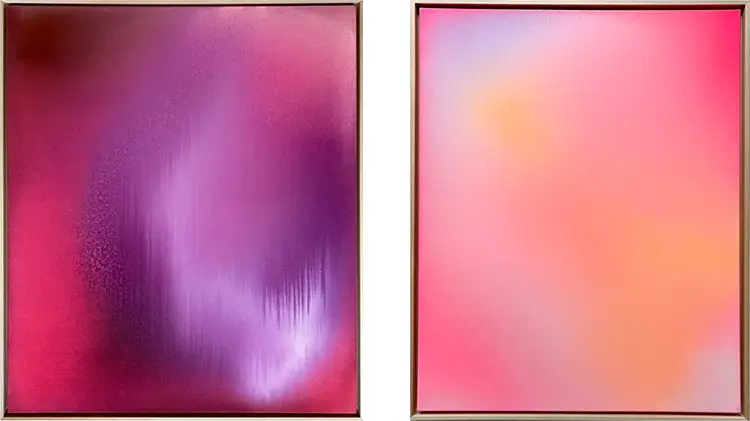
Composition as Conversation: Materials, Motion, and Meaning
A defining characteristic of Ronsdorf’s work is the way materiality becomes inseparable from mood. Whether he’s working with acrylics diluted in water to achieve soft atmospheric veils or layering dense oil paint across a textured surface, the medium itself becomes a vital partner in the act of creation. Spray cans, pastel chalks, pigment sticks, and oil markers each play a role, chosen not merely for their utility but for their ability to extend the emotional register of a painting. This hybrid approach yields compositions that are simultaneously structured and impulsive, balanced yet brimming with kinetic energy.
His sense of color is central to his artistic identity. Vibrant tones interact with more muted shades in ways that feel deliberate yet unforced. Sometimes these decisions occur through meticulous adjustment; other times, color is chosen in an instinctual flash. Ronsdorf describes this interplay as intuitive but never arbitrary. The placement of light and dark, the rhythm between flat planes and expressive marks, all contribute to a dynamic visual language. His paintings function not only as aesthetic experiences but also as invitations for contemplation. The viewer is asked to slow down, to observe the subtle weight of a hue or the delicate edge of a brushstroke.
Each piece is carefully composed, though it rarely feels rigid. Instead, there’s a sense of internal logic within his canvases—a balancing act between chaos and coherence. Light doesn’t merely illuminate; it punctuates. Shapes don’t simply fill space; they suggest emotional states or atmospheric shifts. These works are not bound to narrative or fixed meaning, but they resonate with a sense of intentionality. The abstract forms may appear unstructured at first glance, yet repeated engagement reveals layers of complexity that make each viewing experience different from the last.
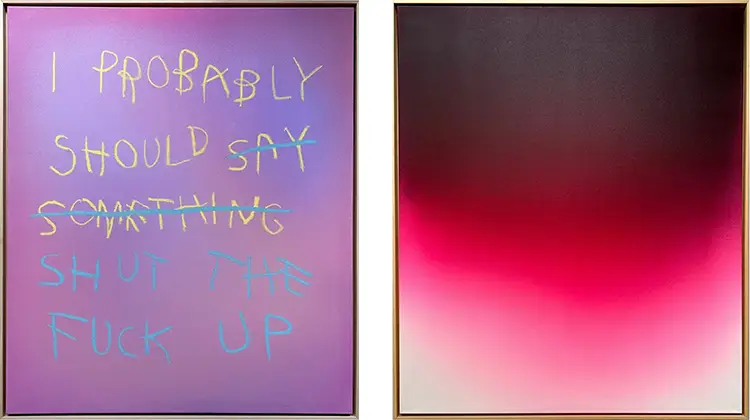
Peter-Maximilian Ronsdorf: Words That Disrupt, Colors That Heal
Beyond the visual interplay of pigment and gesture, Ronsdorf’s use of text introduces another layer of conceptual depth. In certain pieces, emotionally charged phrases are embedded within the surface, scrawled across color fields that might otherwise suggest serenity. One notable work features the phrase “I PROBABLY SHOULD SAY SOMETHING,” only to have it aggressively crossed out and replaced by “SHUT THE FUCK UP.” The bluntness of the language jars against the softness of the background, disrupting the viewer’s comfort and prompting an emotional reevaluation. Here, color is no longer just mood—it becomes context for psychological tension.
This fusion of vulnerability and rebellion aligns with the lineage of artists Ronsdorf admires, particularly Basquiat, who similarly weaponized language within abstraction. However, Ronsdorf’s integration of text does not mimic; it interrogates. The contradiction between form and message becomes a site of friction, where the work’s surface beauty coexists with inner unrest. These pieces resist simplification, allowing complex emotional tones—ranging from quiet despair to ironic detachment—to surface through both text and texture. The handwritten marks, often rough and spontaneous, echo the rawness of his more tactile series, pulling the viewer into a deeper, more unsettled space.
Even when he avoids literal language, the themes in Ronsdorf’s work revolve around internal tension: clarity against confusion, restraint against eruption, softness against force. His art consistently circles around the idea of presence and absence—how something ethereal can carry emotional weight, and how something seemingly aggressive can contain a core of tenderness. Whether he is rendering ethereal clouds of pastel color or scrawling jagged words across a canvas, Ronsdorf remains deeply committed to expressing the multiplicity of feeling that resides within us all. It is this emotional sincerity, paired with his refined visual craft, that sets his work apart in today’s abstract landscape.




